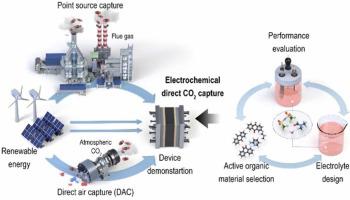Nano Energy ( IF 17.6 ) Pub Date : 2023-05-11 , DOI: 10.1016/j.nanoen.2023.108512 Gwan Hyun Choi , Hyun Jun Song , Seolhwa Lee , Jeong Yoon Kim , Myoung-Woon Moon , Pil J. Yoo

|
The global community has set an ambitious goal of achieving carbon neutrality by 2050. To achieve this goal, significant reductions in carbon dioxide emissions from human activities are required. Carbon capture technology has been identified as a viable solution for addressing global energy depletion and mitigating the effects of fossil fuel consumption on climate change. Recent advances in carbon capture technique based on wet scrubbing have typically focused on increasing carbon capture efficiency. However, this approach requires extensive use of amine CO2 sorbents and high energy consumption for high temperature and pressure operation. An alternative approach is electrochemical direct carbon capture (EDCC), which allows for the capture of CO2 from diluted sources such as direct air capture (DAC) or direct ocean capture (DOC), ultimately resulting in net-zero carbon emissions. Therefore, it is crucial to design cost-effective and energy-efficient CO2 adsorbent molecules for EDCC applications. In this review, we discuss recent advancements in EDCC technology and their potential for future applications, especially using organic active materials. We provide an overview of the fundamentals of EDCC and practical strategies for demonstrating an EDCC system, including molecular design, electrolyte selection, and device configuration. We also delve into design strategies for potential redox-active organic sorbents, with a particular emphasis on understanding currently utilized material candidates from other electrochemical applications and density functional theory (DFT) calculation-guided material selection in the design principle of EDCC. In the final section, we present an opportunity for carbon neutrality utilizing electrochemically-mediated carbon capture technologies. We anticipate that approaches employing an appropriate EDCC design will provide an innovative platform for high-performance and next-generation carbon capture technologies and an opportunity for carbon neutrality.
中文翻译:

使用氧化还原活性有机分子实现碳中和的电化学直接 CO2 捕获技术
国际社会制定了到 2050 年实现碳中和的宏伟目标。为实现这一目标,需要大幅减少人类活动产生的二氧化碳排放量。碳捕获技术已被确定为解决全球能源枯竭和减轻化石燃料消耗对气候变化影响的可行解决方案。基于湿法洗涤的碳捕获技术的最新进展通常集中在提高碳捕获效率上。然而,该方法需要大量使用胺类CO 2吸附剂和高温高压操作的高能耗。另一种方法是电化学直接碳捕获 (EDCC),它允许捕获 CO 2来自稀释来源,例如直接空气捕获 (DAC) 或直接海洋捕获 (DOC),最终实现净零碳排放。因此,设计具有成本效益和能源效率的 CO 2至关重要用于 EDCC 应用的吸附剂分子。在这篇综述中,我们讨论了 EDCC 技术的最新进展及其未来应用的潜力,尤其是使用有机活性材料。我们概述了 EDCC 的基本原理和演示 EDCC 系统的实用策略,包括分子设计、电解质选择和设备配置。我们还深入研究了潜在氧化还原活性有机吸附剂的设计策略,特别强调了解当前使用的来自其他电化学应用的候选材料和 EDCC 设计原理中密度泛函理论 (DFT) 计算指导的材料选择。在最后一节中,我们展示了利用电化学介导的碳捕获技术实现碳中和的机会。


























 京公网安备 11010802027423号
京公网安备 11010802027423号